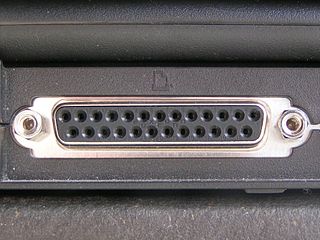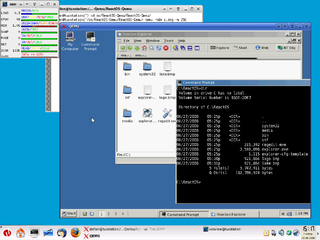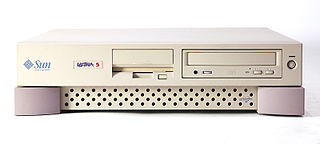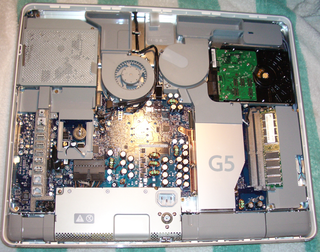
Parallel ATA (PATA), originally AT Attachment, is an interface standard for the connection of storage devices such as hard disk drives, floppy disk drives, and optical disc drives in computers. The standard is maintained by the X3/INCITS committee. It uses the underlying AT Attachment (ATA) and AT Attachment Packet Interface (ATAPI) standards.

Industry Standard Architecture (ISA) is the 16-bit internal bus of IBM PC/AT and similar computers based on the Intel 80286 and its immediate successors during the 1980s. The bus was (largely) backward compatible with the 8-bit bus of the 8088-based IBM PC, including the IBM PC/XT as well as IBM PC compatibles.

Small Computer System Interface is a set of standards for physically connecting and transferring data between computers and peripheral devices. The SCSI standards define commands, protocols, electrical, optical and logical interfaces. SCSI is most commonly used for hard disk drives and tape drives, but it can connect a wide range of other devices, including scanners and CD drives, although not all controllers can handle all devices. The SCSI standard defines command sets for specific peripheral device types; the presence of "unknown" as one of these types means that in theory it can be used as an interface to almost any device, but the standard is highly pragmatic and addressed toward commercial requirements.

In computing, PC Card is a configuration for computer parallel communication peripheral interface, designed for laptop computers. Originally introduced as PCMCIA, the PC Card standard as well as its successors like CardBus were defined and developed by the Personal Computer Memory Card International Association (PCMCIA).

In computing, an expansion card, expansion board, adapter card or accessory card is a printed circuit board that can be inserted into an electrical connector, or expansion slot, on a computer motherboard, backplane or riser card to add functionality to a computer system via the expansion bus.

A parallel port is a type of interface found on computers for connecting peripherals. The name refers to the way the data is sent; parallel ports send multiple bits of data at once, as opposed to serial interfaces that send bits one at a time. To do this, parallel ports require multiple data lines in their cables and port connectors and tend to be larger than contemporary serial ports which only require one data line.

Serial ATA is a computer bus interface that connects host bus adapters to mass storage devices such as hard disk drives, optical drives, and solid-state drives. Serial ATA succeeded the earlier Parallel ATA (PATA) standard to become the predominant interface for storage devices.

The Power Macintosh G3 is a series of personal computers designed, manufactured, and sold by Apple Computer, Inc. from November 1997 to August 1999. It represented Apple's first step towards eliminating redundancy and complexity in the product line by replacing eight Power Macintosh models with three: Desktop and Mini Tower models for professional and home use, and an All-In-One model for education. The introduction of the Desktop and Mini Tower models coincided with Apple starting to sell build-to-order Macs directly from its web site in an online store, which was unusual for the time as Dell was the only major computer manufacturer doing this. Apple's move to build-to-order sales of the Power Macintosh G3 also coincided with the acquisition of Power Computing Corporation, which had been providing telephone sales of Macintosh clones for more than two years.

QEMU is a free and open-source emulator that performs hardware virtualization.
Parallels Workstation is the first commercial software product released by Parallels, Inc., a developer of desktop and server virtualization software. The Workstation software consists of a virtual machine suite for Intel x86-compatible computers which allows the simultaneous creation and execution of multiple x86 virtual computers. The product is distributed as a download package. Parallels Workstation has been discontinued for Windows and Linux as of 2013.

Xbox Linux was a project that ported the Linux operating system to the Xbox video game console. Because the Xbox uses a digital signature system to prevent the public from running unsigned code, one must either use a modchip, or a softmod. Originally, modchips were the only option; however, it was later demonstrated that the TSOP chip on which the Xbox's BIOS is held may be reflashed. This way, one may flash on the "Cromwell" BIOS, which was developed legally by the Xbox Linux project. Catalyzed by a large cash prize for the first team to provide the possibility of booting Linux on an Xbox without the need of a hardware hack, numerous software-only hacks were also found. For example, a buffer overflow was found in the game 007: Agent Under Fire that allowed the booting of a Linux loader ("xbeboot") straight from a save game.

The 3Com Ergo Audrey is a discontinued internet appliance from 3Com. It was released to the public on October 17, 2000 for USD499 as the only device in the company's "Ergo" initiative to be sold. Once connected to an appropriate provider, users could access the internet, send and receive e-mail, play audio and video, and synchronize with up to two Palm OS-based devices.
The Apple Network Server (ANS) was a line of PowerPC-based server computers designed, manufactured and sold by Apple Computer, Inc. from February 1996 to April 1997. It was codenamed "Shiner" and originally consisted of two models, the Network Server 500/132 and the Network Server 700/150, which got a companion model, the Network Server 700/200 with a faster CPU in November 1996.

The i-Opener was a low-cost internet appliance produced by Netpliance between the years 1999 and 2002. The hardware, cheaply available, became popular among collectors who modified the appliance to run as a normal PC. This made the device capable of running PC operating systems, such as Linux and Microsoft Windows.

The Ultra 5 and Ultra 10 are 64-bit Sun Microsystems workstations based on the UltraSPARC microprocessor line available since January 1998 and last shipped in November 2002.

The Sun Microsystems Ultra 80 is a computer workstation that shipped from November 1999 to 2002.

TravelMate is a series of business-oriented computer notebooks manufactured by Acer. Of the various notebook series Acer has offered, the TravelMate is designated as a lightweight business and professional computer built to withstand day-to-day activities. Travelmate laptops are well received by reviewers, often, however, they are faulted for a lack of visual appeal. The TravelMate name was previously used by Texas Instruments, which sold its mobile computing division to Acer in 1997. The TravelMate mainly competes against computers such as Dell's Latitude, HP's EliteBook and ZBook, Lenovo's ThinkPad and Toshiba's Portégé and Tecra.

Hardware of the Macintosh is produced solely by Apple Inc., who determines internal systems, designs, and prices. Apple directly sub-contracts hardware production to external OEM companies, maintaining a high degree of control over the end product. Apple buys certain components wholesale from third-party manufacturers. The current Mac product family uses Intel x86-64 processors. All Mac models ship with at least 1 GB RAM as standard. Current Mac computers use AMD Radeon or nVidia GeForce graphics cards and may include a dual-function DVD and CD burner, called the SuperDrive. Macs include two standard data transfer ports: USB and Thunderbolt. USB was introduced in the 1998 iMac G3 and is ubiquitous today; Thunderbolt is intended for high-performance devices such as external graphics cards.
HP X-Terminals are a line of X terminals from Hewlett Packard introduced in the early- to mid-1990s, including the 700/X and 700/RX, Envizex and Entria, and the Envizex II and Entria II. They were often sold alongside PA-RISC-based HP 9000 Unix systems. The primary use case was connecting several graphical consoles to a single server or workstation to allow multiple users access the same (expensive) processing system from terminal systems. These X-Terminals all allowed high-resolution, color-graphics access to the main server from which they downloaded their operating system and necessary program files. All models featured limited expandability, in most cases additional I/O options for peripherals and memory for more programs or local storage. HP did not use its own PA-RISC platform for these systems, the first design used an Intel CISC processor, while all later systems used RISC platforms, first Intel i960 and later the popular MIPS.
The Ultra 60 is a fairly large and heavy computer workstation in a tower enclosure from Sun Microsystems. The Ultra 60 was launched in November 1997 and shipped with Solaris 7. It was available in several specifications.
















